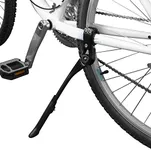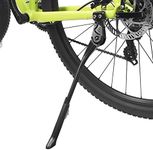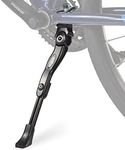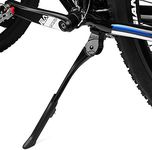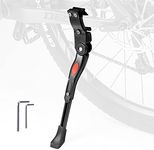Buying Guide for the Best Mountain Bike Kickstands
Choosing the right kickstand for your mountain bike can make a big difference in convenience and bike care. While many mountain bikers prefer not to use kickstands to save weight and avoid snagging on trails, a kickstand can be very useful if you often park your bike in urban areas, at trailheads, or during bikepacking trips. The key is to find a kickstand that fits your bike, matches your riding style, and doesn't interfere with your off-road adventures.Mounting TypeThe mounting type refers to how and where the kickstand attaches to your bike. Common types include rear-mount, center-mount, and chainstay-mount. Rear-mount kickstands attach near the back wheel, center-mount ones go under the bottom bracket, and chainstay-mounts clamp onto the chainstay tube. The right mounting type depends on your bike's frame design and your personal preference. For mountain bikes with sloping frames or rear suspension, a chainstay or rear-mount kickstand is often more compatible. Always check your bike's frame for mounting points or space before choosing.
AdjustabilityAdjustability means whether the kickstand's length can be changed to fit different bike sizes or wheel diameters. Adjustable kickstands are handy if you have a bike with non-standard wheel sizes or if you want to fine-tune the lean angle of your parked bike. Fixed-length kickstands are lighter but may not fit all bikes perfectly. If you want flexibility or plan to use the kickstand on different bikes, look for an adjustable model.
MaterialKickstands are usually made from aluminum, steel, or a mix of both. Aluminum kickstands are lighter and resist rust, making them good for wet or muddy conditions, but they may not be as strong as steel. Steel kickstands are sturdier and can handle heavier bikes, but they are heavier and can rust if not cared for. If you ride in rough terrain or carry gear, a stronger material is better. For casual use, lighter materials may be enough.
WeightWeight is important for mountain bikers who want to keep their bikes as light as possible. Heavier kickstands can add noticeable weight, which might affect your ride, especially on climbs or technical trails. Lightweight kickstands are less intrusive but may not be as durable. If you prioritize performance and ride challenging trails, choose the lightest kickstand that still meets your durability needs. If you use your bike for commuting or touring, a slightly heavier but sturdier kickstand may be acceptable.
StabilityStability refers to how well the kickstand keeps your bike upright, especially on uneven ground. Some kickstands have a wide foot or even two legs for extra stability, which is useful if you often park on soft or sloped surfaces. Single-leg kickstands are lighter and simpler but may tip over more easily. If you carry gear or park on rough ground, look for a kickstand with a broad, non-slip foot or a double-leg design.
CompatibilityCompatibility means whether the kickstand will fit your specific bike frame and wheel size. Not all kickstands fit all mountain bikes, especially those with unique frame shapes, rear suspension, or disc brakes. Always check the manufacturer's guidelines for frame and wheel compatibility. If your bike has unusual features, you may need a kickstand designed for those specifics. Ensuring compatibility prevents installation issues and damage to your bike.

